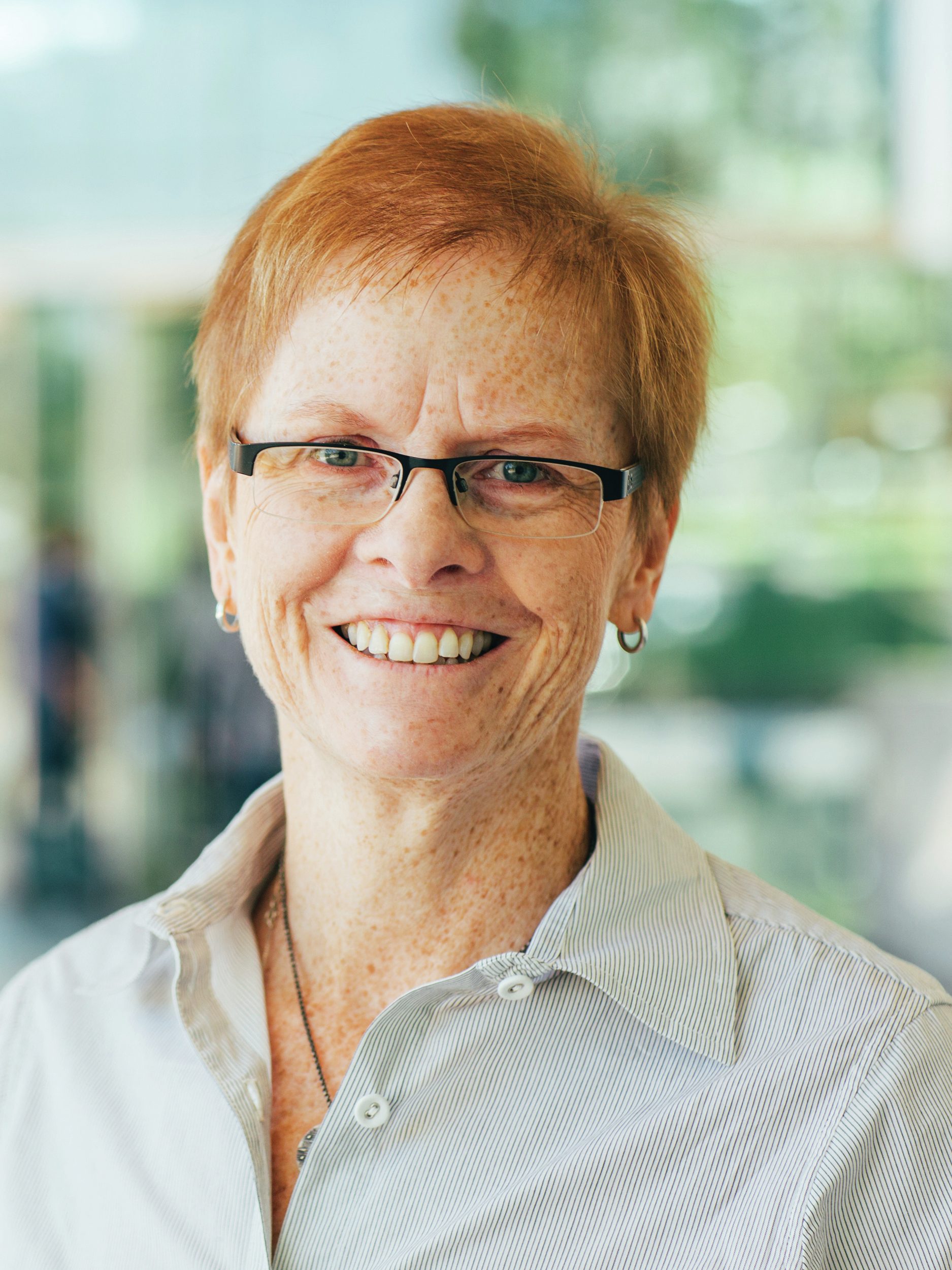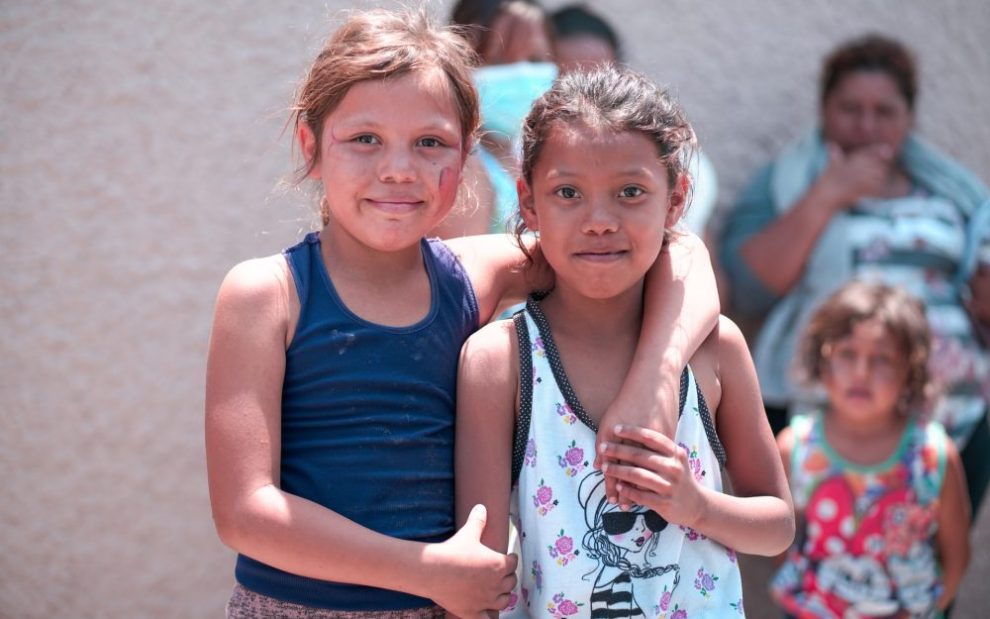This interview is an edited and abridged version of Linda Dakin-Grimm’s interview with Jeannie Gaffigan and Mike Lewis on the Field Hospital podcast.

What wound do you think needs healing in the Catholic Church?
This is the question that Jeannie Gaffigan, writer and executive producer of The Jim Gaffigan Show, and Mike Lewis, editor of the website Where Peter Is, ask every guest on U.S. Catholic’s new podcast, Field Hospital. The term is taken from Pope Francis, who describes the church’s mission by saying, “It is useless to ask a seriously injured person if he has high cholesterol and about the level of his blood sugars! You have to heal his wounds. Then we can talk about everything else.”
For author and lawyer Linda Dakin-Grimm, one of these wounds is the lack of care for immigrants and refugees in our country. When she first saw kids coming into the United States unaccompanied, Dakin-Grimm says, she blamed it on a failure of parenting. “These kids are somebody else’s problem,” she says of her thinking. But then she started looking at what scripture says about welcoming the stranger. Now, she says, “I can’t be a Catholic . . . and go blithely living my upper-middle-class life in white suburbia” with no concern for immigrant and refugee children.
Since 2016, when Dakin-Grimm started working pro bono on immigration, she has worked with more than 75 unaccompanied children and separated families. In 2020 she published a book about her work titled Dignity and Justice: Welcoming the Stranger at Our Border (Orbis Books).
In this abridged version of her conversation with Gaffigan and Lewis, Dakin-Grimm speaks about the individuals she’s encountered in her work and how her faith drives her to help these children and families.
Mike Lewis: You spent most of your career as a lawyer doing business trials. How did you become involved in immigration issues?
I was a business trial lawyer for many years, and I shifted gears about 10 years ago. Two things led to that. One was a deepening of my faith and a realization that when you turn 50, life seems more real. I wanted to do something that contributed to the common good. Second, a friend who was a pastor in a neighboring parish asked me if I would look into something relating to DACA (Deferred Action for Childhood Arrivals). And I said, “Of course, I will,” but I didn’t know what DACA was. I didn’t know anything about immigration.
As I started researching, I came across an organization called Kids in Need of Defense (KIND), which works with kids who come to the border unaccompanied. I took one case from them, met an actual child, then took 10 more. And then it just took over my life. I felt that the invitation from my friend was one of those God moments where I was led to shift and do something different.
Jeannie Gaffigan: How does your Catholic faith inform your thoughts about immigration?
When I realized that my faith needed to be the center of my life, I also realized that I didn’t understand my own faith. So I went back to school and studied theology at Loyola Marymount University in Los Angeles. And that’s where I learned a
version of my faith that wasn’t the fifth-grade memorized answers that I vaguely remembered. What I learned informs really everything I do. Catholics have a wealth of beautiful teachings that the magisterium has put forward for centuries.
When I first noticed kids coming to the country unaccompanied, I was kind of judgy: I thought, “Well, why are they flooding the border? And where are their parents? This must be their parents’ fault. These kids are somebody else’s problem.” But when I started looking at what the church teaches about immigration, it changed my way of thinking.
There are very clear commands in the Hebrew Bible to welcome the stranger and treat them as a citizen. In the New Testament, Jesus is also really clear: He says in Matthew 25 that his followers are going to be surprised at the end of time when they are separated into the sheep and the goats, and the ones who didn’t welcome the stranger are going to go off with the goats. I look at things like that and think, “These are really foundational teachings for us. I don’t want to be a goat.”
ML: It seems that Catholics tend to get pulled into political discourse on immigration without reflecting on what the church teaches. What type of immigration policy should Catholics support?
I think the first principle is the Catholic idea of the common good. This means that we recognize everyone in the world is entitled to what is necessary to live a life where they can find God.
Sts. Augustine and Thomas Aquinas tell us what we should never do if we’re going to support the common good. Essentially, we’re not supposed to cooperate with anything that is destructive of life. We certainly don’t have to have open borders, but as Catholics we have to welcome and support people whose lives are in jeopardy and children who are separated from their parents. So the lens of life is what we as Catholics are required to bring to the issue of immigration.
JG: How are the children you’ve worked with facing life or death situations? Do they have to prove they were persecuted, and how do they do this after traveling across several countries alone?
They absolutely have to prove it. In my book I talk about one of my clients, Rosalina, who came to the United States by herself. She’d never eaten meat in her life, not because she is a vegetarian, but because her family had never been able to afford it. She is a 70-pound, 5-foot-tall girl who was offered some chicken in a shelter and got really ill.
Rosalina was able to apply for something called Special Immigrant Juvenile Status (SIJS), which applies to children from other countries who have been abandoned, abused, or neglected by one or both of their parents in their home country. Reunification with that parent isn’t viable, and it’s in the child’s best interest to stay in the United States.
But how does a child who comes to the United States not speaking a word of English, who is malnourished, who hasn’t been able to attend school, prove that? By the way, there’s no entitlement like in TV shows when the cop reads the Miranda warning that if you can’t afford a lawyer, one will be appointed for you. In the immigration system you can bring a lawyer if you can get one, but there’s no right to a lawyer.
The SIJS process not only involves appearing in immigration court, which is a federal process but also requires the child to go into the state court system and persuade a family or juvenile court judge.
That’s why KIND finds lawyers to work pro bono with kids like this: to gather the proof they need, contact family members, and document their stories.
ML: Where are these children while all this is taking place?
The law provides some protections for kids who are unaccompanied, and it did so even during the four years of the Trump administration. The children can only be kept at a border station for adults for 48 hours. Then they have to be turned over to the U.S. Department of Health and Human Services, which runs a bunch of detention centers for children.
Some of these kids stay there for their whole case if they don’t have a relative, a friend, or somebody to whom they can reach out and say, “Can I live with you while I’m going through this process?” There is very minimal access to lawyers in these facilities. They may have some help, but the chances that they would find a lawyer to pursue SIJS is pretty unlikely.
But if a relative will say, “I will take care of the kid. I will enroll them in school. I will feed and clothe them, and I will bring them to all their immigration court hearings while you try and deport them,” then the kids are released to that sponsor. So that’s where most of the kids that I have represented are: They’re living with a sponsor. But they know that the clock is ticking and they’re either going to have to prove their status or they’re going to get an order of deportation from an immigration judge.
ML: How does a child come from Nicaragua or somewhere in Central America and wind up speaking to you in Los Angeles?
There are a million ways, frankly. The youngest kids I’ve represented were 9. Those kids’ arrangements were undoubtedly made by somebody in their home country who recognized that the kid was not going to have a sustainable life in that country. But I’ve also represented many, many kids who were young teens who walked, begged, rode on top of the train, or took buses.
Some of the kids know somebody in the United States. I represented a young girl from Guatemala whose mother had left her to come to the United States to work and send money back. This young girl kind of fantasized, I think, that her mom would be a wonderful person, but she didn’t really know her beyond as a voice on the phone.
This girl tried three different times to come and rejoin her mom before actually succeeding at age 13. The first time, she got violently ill in Mexico, almost died in a hospital, and was sent back to Guatemala. The second time, she was intercepted by Mexican police and sent back to Guatemala. The third time, she got to the border.
There’s some real desperation in that girl’s story. Nobody made arrangements or hired a smuggler or anything like that: She was just desperate to come. Unfortunately, her mother had a new family here with three little kids and a new significant other, and the girl wasn’t really welcome. It’s not all fairy-tale family reunions. But she persevered and graduated high school and eventually did get her green card. She’ll be a citizen in this country and wants to work in law enforcement. The sheer life force that I see in these kids is really what keeps me going.
There’s another young man named Manuel who knew very young that he was gay, and his parents threw him out. It’s impossible to be a gay youth in El Salvador. He was trying to go to school, working in restaurants, washing dishes, and couch surfing. His parents didn’t send him to the United States so that he could support them or anything like that: He just was tired of being beaten up and abused and afraid for his life. I wish I could show you the photo of him that he sent me when he received his green card.
On the wall behind him were all these framed certificates that he had earned in the adult high school he was going to. He was so proud of them. These kids are our future.
JG: As an American, an immigration lawyer, and a Catholic, what is your dream proposal for immigration reform?
I’ll tell you this while recognizing that Congress is not listening to me and it’s not likely to happen anytime soon, but I think we need to do a few things. One, we need to change and broaden the definition of who qualifies for asylum and who is a refugee so that we address the situations real people find themselves in. This will include, increasingly, climate-driven refugees and people escaping war and poverty.
The other thing that we need to do is to take a look at the extremely tight limitations on what people think of as legal immigration. The very tiny number of people we allow to come to the country with employment-based and family-based immigration was established in a different world. Our population is changing: There’s not going to be anybody in the country to take care of people as we get older. We’re not replicating ourselves.
ML: How has climate change affected migrants and immigration?
In 2020 climate extremes displaced 30 million people from their homes, according to the United Nations. In those countries, which tend to be closer to the equator, conflict and violence within societies have tripled. Things like floods, hurricanes, and heat have made it impossible to live places. But even in places where life is possible, tensions within the community have increased violence.
People from these areas are eventually finding their way to our borders. Whatever you think is causing climate change, the fact that it is happening is pretty undeniable. So what are we going to do for these people? We can argue about whether humans have caused an acceleration of climate change, but you really can’t argue that it has occurred and that people are on the move and that more people will be on the move in the next 10 to 20 years.
But under the legal system as it exists now there is no box for those people to check and say, “Can I come into your country? My country is not possible to survive in.” That’s something else that we need to modify in our law. Otherwise, life just becomes a big game of musical chairs: “Well, I’m lucky enough to have been born in the time I was born in North America. You weren’t born there, so you don’t get a chair.” That’s not really what Jesus was about.
JG: Is it possible to have a personal relationship with Jesus and look at these situations and say, “You know what? I’m too busy. I’m afraid of these people. I need to turn my back on this situation”?
I don’t see how we can look away given who Jesus was when he was on Earth, what he did, and what he tells us to do in scripture. However, I spent many, many years looking away. I’m not in a great position to condemn my fellow Catholics. What I’d like to say is this: “Hey, look back over here, look over here. Look what Jesus said.” I think this teaching is really radical. And once I looked at it with clear eyes and stopped being distracted, I couldn’t be a different kind of Catholic.
Pope Francis is one who would say, “Who am I to judge?” I don’t think it’s my job to judge other people. We’re called to look at those who abuse others as humans too. Just like we see the face of Jesus in migrants.
So no, I can’t be a Catholic and have a relationship with Jesus and go blithely living my upper-middle-class life in white suburbia anymore. But I also can’t condemn people who are on a different timeframe or another path. And I think Pope Francis’ field hospital is trying to be inclusive and bring all of us along at whatever pace we can make the journey.
This article also appears in the May 2022 issue of U.S. Catholic (Vol. 87, No. 5, pages 32-35). Click here to subscribe to the magazine.
Image: Unsplash/Barbara Zandoval













Add comment